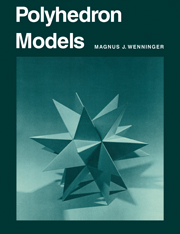Book contents
- Frontmatter
- Dedication
- Contents
- Preface to 1978 reprint
- Preface
- Foreword
- Introduction: uniform polyhedra
- Mathematical classification
- Section I The Convex Uniform Polyhedra: The Platonic and Archimedean Solids
- Section II Some Stellations and Compounds
- Section III Non-convex Uniform Polyhedra
- Epilogue
- References
- List of models
Preface to 1978 reprint
Published online by Cambridge University Press: 05 August 2015
- Frontmatter
- Dedication
- Contents
- Preface to 1978 reprint
- Preface
- Foreword
- Introduction: uniform polyhedra
- Mathematical classification
- Section I The Convex Uniform Polyhedra: The Platonic and Archimedean Solids
- Section II Some Stellations and Compounds
- Section III Non-convex Uniform Polyhedra
- Epilogue
- References
- List of models
Summary
The study of polyhedra is one area of mathematics in which the ordinarily abstract and speculative considerations of the subject find very pleasing and attractive visual applications. It is also an area in which both the amateur and the expert in mathematics can work with equal delight.
The enthusiastic response which greeted the first publication of this book (1971) provided ample evidence of this fact, as well as its appearance in a paperback edition (1974), reprinted in a hardcover edition (1975, 1976) and now in still another reprint (1978).
A book which contains as many geometrical drawings as this one, all of which demanded careful draughtsmanship in the originals, could hardly have been printed without errors in their reproduction. Every effort was made to correct these where feasible in the reprinted editions. Further corrections are being incorporated in this present edition.
A word of caution is in place here for the dedicated model maker. Although the original intention of the book was to provide patterns that can be traced from the book and thus used directly in making the models, you may find that for best results very careful workmanship still demands that you make your own full scale drawings of all facial planes from which the patterns or nets are derived.
For the beginner or the inexperienced this has great educational value. For those who already possess the required expertise this will avoid their being led astray by the book. On the other hand in all cases it must be remembered that a model is a model. The full delightfulness of any polyhedron model must ultimately be a matter of intellectual insight.
It may be of interest for readers to know that a definitive enumeration of uniform polyhedra has now been made. John Skilling of the Department of Applied Mathematics and Theoretical Physics at the University of Cambridge has shown that ‘the list of Coxeter et al. is indeed complete as regards uniform polyhedra in which only two faces meet at any edge.
- Type
- Chapter
- Information
- Polyhedron Models , pp. viiiPublisher: Cambridge University PressPrint publication year: 1971



